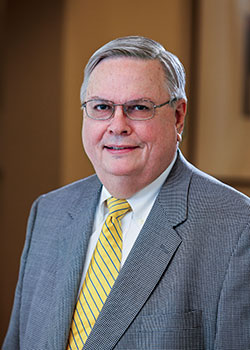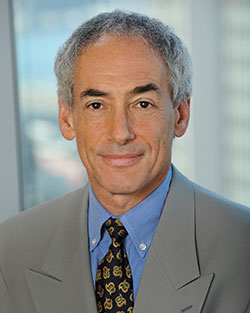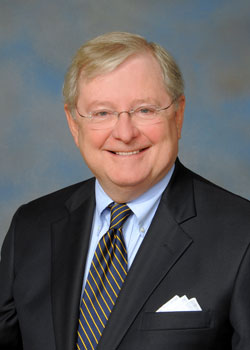In the span of a few short months, the tax world lost three individuals—Matthew Rosen, Ken Gideon, and Phil Mann—who each left an indelible mark on tax law and tax practice. All three were affable, witty, and wise and possessed impeccably good judgment. They cared deeply about their families, friends, colleagues, and clients. Even among giants of the tax bar, they were giants. I had the great fortune of counting two of them as partners and all three as friends and mentors. What follows is a short recounting of their contributions to the tax world.
Ken Gideon (1946–2016)
 I first met Ken Gideon when he was President Ronald Reagan’s nominee to be chief counsel for the Internal Revenue Service. A partner at Fulbright & Jaworski in Houston when President Reagan nominated him, he was just thirty-four years old but had already chaired an important committee of the ABA Tax Section—Court Procedure—and grappled with the impact of audits of mass-marketed partnership tax shelters on the IRS and U.S. Tax Court. Designing a means for the IRS and Tax Court to manage the inventory of audits and docketed cases was one of Ken’s most significant contributions to the tax system. Congress enacted the partnership audit provisions in 1982 that came to be known as the TEFRA audit provisions. Though not a model of administrative simplicity, the TEFRA audit provisions featured significantly in how the IRS and Tax Court got a handle on the burgeoning number of cases, and they survived until December 2015, a month before Ken’s passing.
I first met Ken Gideon when he was President Ronald Reagan’s nominee to be chief counsel for the Internal Revenue Service. A partner at Fulbright & Jaworski in Houston when President Reagan nominated him, he was just thirty-four years old but had already chaired an important committee of the ABA Tax Section—Court Procedure—and grappled with the impact of audits of mass-marketed partnership tax shelters on the IRS and U.S. Tax Court. Designing a means for the IRS and Tax Court to manage the inventory of audits and docketed cases was one of Ken’s most significant contributions to the tax system. Congress enacted the partnership audit provisions in 1982 that came to be known as the TEFRA audit provisions. Though not a model of administrative simplicity, the TEFRA audit provisions featured significantly in how the IRS and Tax Court got a handle on the burgeoning number of cases, and they survived until December 2015, a month before Ken’s passing.
Ken brought to the IRS an exquisite appreciation of the importance of transparency. Transparency today is associated with demands for more information from and about taxpayers by taxing authorities, NGOs, and politicians. Transparency’s meaning as a key measure of a tax system’s quality has been largely forgotten. Transparency in the context of a tax system means that taxpayers know what the rules are and what is required of them. Although Ken could savor the intricate beauty of a complex design, he understood that complexity that baffled mere mortals would undermine respect for the system and that the system depended on taxpayers voluntarily doing what the law required. He also understood the danger of uncertainty in the tax law. Anti-avoidance rules might be unavoidable, but his default position was that clear rules, not smell tests or how something looked to the tax collector, should determine outcome.
Although Ken could savor the intricate beauty of a complex design, he understood that complexity that baffled mere mortals would undermine respect for the system and that the system depended on taxpayers voluntarily doing what the law required.
A fiscal conservative and a native of Lubbock, Texas, Ken was no advocate of big government, but he firmly believed in fiscal responsibility—that the government should collect enough in taxes to cover the obligations its duly elected leaders had enacted. Similar fiscal conservatism earned former Senator Bob Dole the epithet of “tax collector for the welfare state.” But labels didn’t trouble Ken or prevent him from doing what he thought was right. Sticks and stones, he would say, leaving you to complete the rhyme. In addition to the partnership audit provisions, the 1982 legislation—the Tax Equity and Fiscal Responsibility Act—was loaded, as its name implies, with revenue-raising compliance provisions and reversals of so-called supply-side tax cuts enacted just the previous year. Ken’s role as chief counsel was to ensure the production of guidance on an expedited schedule so that affected parties could comply. He delivered. I had the responsibility for drafting regulations on withholding on interest and dividends, a provision so controversial that Congress repealed it a few days after it took effect. But that repeal was three months after the IRS had produced 200 pages of final regulations and only seven months after the statute was enacted, a feat made possible by Ken’s organizational skills, management style, and ability to cut to the chase (a favorite expression of his), and the confidence in his judgment he had earned from his colleagues.
That was not Ken’s sole experience with controversial revenue-raising provisions. He went back to Fulbright & Jaworski in 1983, but returned to government as President George H. W. Bush’s assistant treasury secretary for tax policy in 1989, playing an integral role in the 1990 budget agreement where President Bush was said to have broken his “read my lips, no new taxes” campaign pledge, a break that was often blamed for his 1992 election loss. Much as Ways and Means Committee Chairman Al Ullman’s election loss—following his proposal of a value-added tax—lives on in tax lore as the political reason the United States does not have a VAT, President Bush’s loss lives on in anti-tax-increase, election-year campaign pledges.
Ken was a studious observer of facts, never an ideologue. “What are they smoking?” he would ask rhetorically about someone holding fast to a view in the face of overwhelmingly contrary evidence. The facts as Ken saw them did not support the proposition that tax cuts paid for themselves. But even if they had, the 1990 political reality was that a budget deal, which he clearly believed to be in the best interest of the country, would happen only if the Republican White House and Democratic-controlled Congress reached agreement. A deal required concession on a tax increase.
The partisan politics that left its mark during Ken’s Treasury tenure contrasted with the bipartisan atmosphere of the early 1980s. In Ken’s view, that partisanship put politics above the best interests of the country and marked the beginning of the hyperpartisanship prevalent today. When I joined Treasury in 2001, he warned of ideologues and worried that partisanship would make it difficult to get anything done. We were partners by then in the Washington office of Skadden, Arps, which Ken had joined just a few weeks before. His worries proved accurate, but did not deter his enthusiastic support for Treasury service.
Ken had immense respect for the law. He believed his responsibility as chief counsel and later assistant secretary was to interpret the law, not to revise it to reflect his view of what Congress or the courts should have written. His respect for the law infused the advice he gave clients. He was a fabulous technician, but also a trusted advisor, because he could tell his clients not just what the law said but how the IRS or a court might apply it to their circumstances. He inspired confidence because he told clients what they needed to know, not what they wanted to hear.
Ken cared deeply about the tax system and the legal profession. He devoted years, and countless hours, to the ABA Tax Section, which he chaired a decade ago. For some of us, serving as Tax Section chair graces our résumés. In a few rare cases, the role is graced by its occupant. Ken was that rarity. Following his tenure as Tax Section chair, Ken served as a Tax Section delegate to the ABA House of Delegates and on the ABA Board of Governors, thankless, time-consuming jobs requiring the patience of Job, but important to the Tax Section’s successful functioning.
Ken was a gifted writer—well, at least for a tax lawyer. While he appreciated sarcasm and was known to utter an ad hominem remark, when his briefs were final, they succeeded because of his skill as an advocate in constructing persuasive arguments, not from insulting or ridiculing opposing views or slinging mud at the other side. Ken had a delightful sense of humor, often giggling at his own jokes in a way incongruous with his size. He was a lover of country music song titles, if not the songs themselves. One of his favorites was “(Happiness Is Lubbock) Texas in My Rear View Mirror,” irony fully intended. Another favorite, regularly employed when he ’d had enough of an argument, was “Here’s a Quarter (Call Someone Who Cares).”
If I had ever had to hire someone for a tax case, I would have hired Ken. I can think of no greater professional compliment. From discussions with clients coming to terms with his unexpected passing, I understand their sense of loss. When Ken became assistant secretary of Treasury in 1989, I contemplated leaving Skadden to work for him there. Ken’s advice was “Stay at Skadden and get your spurs,” observing that even former chief counsels were “a dime a dozen in Washington.” On that one score—the measure of his value—Ken was wrong.
Matthew Rosen (1952–2015)
 Matthew Rosen was simply brilliant. I first met Matthew in 1986 when I was leaving the IRS chief counsel’s office for the private sector and interviewing with Skadden, Arps. Charles Morgan, then the IRS associate chief counsel (technical), had decided to return to private practice and to join Skadden’s New York tax practice. Fred Goldberg, Ken Gideon’s successor as IRS chief counsel, had decided to join the firm as well to begin a tax practice in Skadden’s Washington office. Jim Levitan led the Skadden tax practice at the time, and Matthew was one of three stellar young tax lawyers, Barney Phillips and Phil Adams being the other two. Together they were a key part of Skadden’s top-ranked merger and acquisition team, led by Joe Flom, that upended the staid world of corporate law by being willing to represent unwanted suitors in corporate takeover fights.
Matthew Rosen was simply brilliant. I first met Matthew in 1986 when I was leaving the IRS chief counsel’s office for the private sector and interviewing with Skadden, Arps. Charles Morgan, then the IRS associate chief counsel (technical), had decided to return to private practice and to join Skadden’s New York tax practice. Fred Goldberg, Ken Gideon’s successor as IRS chief counsel, had decided to join the firm as well to begin a tax practice in Skadden’s Washington office. Jim Levitan led the Skadden tax practice at the time, and Matthew was one of three stellar young tax lawyers, Barney Phillips and Phil Adams being the other two. Together they were a key part of Skadden’s top-ranked merger and acquisition team, led by Joe Flom, that upended the staid world of corporate law by being willing to represent unwanted suitors in corporate takeover fights.
Whether admired for their audacity or feared for their pugnaciousness, the Skadden team brought fresh thinking that challenged conventional wisdom and changed the face of corporate America. Temerity on the corporate side was matched by a willingness to think outside the box on the tax side to achieve a client’s objective, or at least to ensure that a solid business plan was not submarined by excessive taxes on the transaction.
My decision to join Skadden’s tax practice wasn’t difficult. The firm had a vibrancy and infectious energy I recall vividly. Support staff were available twenty-four hours a day, 365 days a year. So were the partners. I learned quickly after joining Skadden what life was like when you were working on a deal: an intense, round-the-clock effort that required you to bring your very best every hour of every day. The capacity to sustain that kind of performance, while leading the practice for an extended period, is a testament to Matthew’s fortitude.
In collaborative exercises to solve complex tax problems, it can be difficult to credit any one person with authorship of a new idea. Suffice it to say that Skadden was there at the inception of novel solutions to tax issues like mirror transactions, alphabet stock, and creative uses of vehicles and instruments like installment notes, and that Matthew worked on some of the most innovative transactions, developing solutions to difficult problems that no one else had thought of and providing practical paths for clients to realize their business objectives.
When Jim Levitan retired, Matthew took over as co-head of the tax practice, a spot he held for twenty-five years until he retired, intent on beating the cancer that would soon claim his life. The tax department Jim left behind was famously cohesive, collaborative, and consultative. Corporate partners would complain of the “tax six-pack” that arrived when they called to consult with one of the tax partners. Why, they wanted to know, if I call you, Matthew, do I end up with five others? The answer, as any tax person knows, is that tax is complicated and advice is better when it is a product of consultation with other smart tax lawyers.
What impressed me even more than his encyclopedic knowledge was Matthew’s ability to extract essential factors and conclusions from the knowledge to apply to the facts at hand and suggest a solution that fit the client’s needs.
Matthew had a wonderful sense of humor, often self-deprecating, and an ear for impersonation. Once while he stood behind a lectern addressing an annual partner meeting, a wag in the audience yelled, “Stand up, Matt!” Without the slightest pause in his presentation, Matthew, who was as diminutive as Phil Adams was tall, lapsed into an impersonation of Phil, making the audience convulse with laughter.
Matthew had an encyclopedic knowledge of the tax law and could recite details of statutes, regulations, cases, revenue rulings, and PLRs on any subject related to mergers and acquisitions or corporate taxation. The encyclopedic knowledge and his memory for details always amazed me. I recall working on a transaction requiring an opinion on which I wanted Matthew’s view. I had a foggy recollection that we had worked on a similar transaction some years previously. Matthew recalled the prior transaction in detail, how we had analyzed it, and how the law had changed in the intervening years. What impressed me even more than his encyclopedic knowledge was Matthew’s ability to extract essential factors and conclusions from the knowledge to apply to the facts at hand and suggest a solution that fit the client’s needs.
Former IRS Associate Chief Counsel Bill Alexander, who joined Skadden to work with Matthew just a few months before Matthew took ill, described Matthew as the rare combination of creativity and good judgment. He sorted what mattered from the distraction. He advocated for his client with an understanding of what mattered to the government.
Matthew was known for his humility, patience, and mentorship of other lawyers. Skadden tax partner Stu Finkelstein described Matthew as the smartest tax lawyer he ever met, yet humble in his dealings with others. He said Matthew “had a talent for taking your words and turning them into something much more coherent,” that he would “tell you what you really meant, which usually wasn’t the case, but he wanted to make you feel like it was your idea all along.” Another Skadden tax partner, Victor Hollender, described Matthew as having “a radiant and brilliant mind together with a patient and humble temperament.” He described Matthew as having the capacity to make you “realize that when you thought you were finished in your analysis, you were really just beginning,” and to do so with a genuine concern for your development “as deep as his commitment to his practice.”
Phil Mann (1939–2016)
 When I think of Phil Mann, I think of the question, “If it’s called common sense, why is it so uncommon?” Phil had an uncommon amount of common sense. He was an Okie to the core, which may have been the source of his immense common sense and perhaps the respectful manner with which he treated others. Whether one was on his side or his opponent’s, Phil Mann treated everyone with respect and, as Eric Solomon observed in a remembrance of Phil, graciously. Phil epitomized graciousness. He was a gracious advocate, a gracious opponent, a gracious colleague, and a gracious host.
When I think of Phil Mann, I think of the question, “If it’s called common sense, why is it so uncommon?” Phil had an uncommon amount of common sense. He was an Okie to the core, which may have been the source of his immense common sense and perhaps the respectful manner with which he treated others. Whether one was on his side or his opponent’s, Phil Mann treated everyone with respect and, as Eric Solomon observed in a remembrance of Phil, graciously. Phil epitomized graciousness. He was a gracious advocate, a gracious opponent, a gracious colleague, and a gracious host.
Phil delivered sage advice in pithy one-liners. My favorite: “Sometimes the best thing you can tell your client is no.” Phil could also deliver the answer to complicated questions in one-liners that began with, “Look, the bottom line
is. . . .” Like Ken Gideon’s “cut to the chase,” Phil could cut to the bottom line of a complicated issue faster than anyone I’ve seen.
I first met Phil while I was working in the chief counsel’s office in the early 1980s. Phil was a partner at Miller & Chevalier by then. Like Ken, he began his career with Fulbright & Jaworski in Houston and then was persuaded to come to Washington to work in Treasury’s Office of Tax Policy with Assistant Secretary Fred Hickman in the 1970s. There he worked with Jack Nolan, a man many regarded as the dean of the tax bar. Jack mentored Phil and, some years later, persuaded Phil to leave Fulbright to join him at Miller. Phil spent the remainder of his career with Miller, eventually leading the firm until a few months before he passed away.
When Phil joined Miller & Chevalier, he joined the quintessential Washington tax practice. Miller advised the largest companies in the country on the most challenging issues they faced. If a client faced a roadblock, there was no firm better equipped to find a route to achieve the ultimate goal. They knew where all the levers were and how to pull them. They understood how to “elevate” issues long before elevating an issue had rules of engagement. They were successful not because they were adept with the levers, however, but because they were guided by a clear sense of what was right. Phil always knew where the line was and when a position crossed it. Clarity about the merits of a position was why, when Miller & Chevalier came to call, the argument merited careful consideration.
Like Ken Gideon, Phil spent years and countless hours on ABA Tax Section activities, eventually leading the Section in the late 1990s. Phil was committed to tax law “improvement” and determined to better the ABA Tax Section’s contribution to improving the tax law. Phil wanted the ABA Tax Section engaged in providing comments on IRS regulations and guidance, but he wanted those comments fair, balanced, and free from bias. He characterized the ABA’s comments as often “petty” instead of constructive. The comment process was changed to ensure a better result. I recall a criminal defense lawyer once asking me why the Tax Section spent time on issues with no apparent benefit for their clients. The reason was the influence of lawyers like Phil who understood first and foremost that the tax system depended on the public’s belief that the system worked as it should.
Phil delivered sage advice in pithy one-liners. My favorite: “Sometimes the best thing you can tell your client is no.”
As Phil was assuming a leadership role in the ABA Tax Section, he was particularly concerned about the rise in “dodgy” tax deals and about the role lawyers were playing in those deals. He described some of the opinions clients sent him for a second opinion as “not worth the paper they’re printed on.” Phil’s leadership led to the formation of the Tax Section’s tax shelter task force. Membership was by invitation, and it met in executive session, which allowed for candid discussion of the issues and what the Tax Section could do. The Tax Section’s activities eventually led to changes in the rules governing writing tax opinions and providing tax advice. I was part of the effort to revise Circular 230 during my time as assistant secretary. Phil’s ABA leadership made the discussion of changes to Circular 230 possible. The standards of practice he set at Miller & Chevalier provided an aspirational model for how lawyers should practice.
Phil stayed deeply involved in ABA Tax Section activities after he had completed his term as chair, but always focused on the practical side. Serving in the ABA House of Delegates—student council for grown-ups, as his good friend Paul Sax called it—would never have suited Phil. He was a member of the IRS Advisory Council, counseled the IRS as it reorganized in the late 1990s, and served as the Tax Section’s liaison to the IRS’ large and midsized business division.
Phil had a genuine interest in getting to know his clients, government officials, fellow professionals, and the associates who joined—and sometimes left—Miller & Chevalier. It made life more interesting and the profession more rewarding. He believed a balanced life was important. He and his wife Barbra loved opera, Rome, fine red wine, and hosting dinner parties (not necessarily in that order), and visiting their children and grandchildren with whom they spent as much time as possible. By how he lived and practiced, Phil taught many of us valuable life lessons. To the extent that we live up to his standard of graciousness and respect for others and their opinions, Phil lives on in us.
Pamela F. Olson is U.S. deputy tax leader and Washington national tax services practice leader at PricewaterhouseCoopers LLP.




